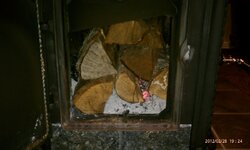Thanks to the many voices here on this forum I've managed a clean and safe install of my new to me, Hearthstone Heritage. Ive begun burning regularly after a couple of quick break in fires and am disappointed in the heat output of the stove. It should be mentioned that my wood is marginal in its moisture content, with most splits, after a resplit and center measurement coming in at an overall average of 20 to 23 percent moisture. With this less than ideal scenario I should also mention that I've, as per suggestions here purchased some biobricks to help my marginal wood out.
The problem I'm having is that even with 3 to 4 biobricks added to the firebox I can't seem to get the stovetop temps much above 300f. as measured by a Rutland magnetic stovetop thermometer placed as close to the center of the stove as possible without actually placing it on the top steel block off plate.
It should be noted that Ive only been able to see the very back row of secondary tubes outputting any flame and also that when I go outside the chimney is outputting NO visible smoke which leads me to believe that the wood is, at the very least burning completely. It should also be noted that even when I fill the firebox with ONLY biobricks the temps are still hard pressed to exceed 300f.
Is it my wood? Is it the fact that only the rear secondary tube is outputting flame? Or could it be a poor draft? The chimney is over 20 feet of insulted 6 inch stainless flex liner. The firebox fills with plenty of flame and on these not so cold New England nights the output is plenty to keep the Propane furnace from going on. Any input is greatly appreciated.
The problem I'm having is that even with 3 to 4 biobricks added to the firebox I can't seem to get the stovetop temps much above 300f. as measured by a Rutland magnetic stovetop thermometer placed as close to the center of the stove as possible without actually placing it on the top steel block off plate.
It should be noted that Ive only been able to see the very back row of secondary tubes outputting any flame and also that when I go outside the chimney is outputting NO visible smoke which leads me to believe that the wood is, at the very least burning completely. It should also be noted that even when I fill the firebox with ONLY biobricks the temps are still hard pressed to exceed 300f.
Is it my wood? Is it the fact that only the rear secondary tube is outputting flame? Or could it be a poor draft? The chimney is over 20 feet of insulted 6 inch stainless flex liner. The firebox fills with plenty of flame and on these not so cold New England nights the output is plenty to keep the Propane furnace from going on. Any input is greatly appreciated.



 variation, depending upon where you measure it on the top alone. As Highbeam posted, it does take awhile to get a soapstone up to temp but it stays warm for so much longer.
variation, depending upon where you measure it on the top alone. As Highbeam posted, it does take awhile to get a soapstone up to temp but it stays warm for so much longer. ) and more primary air longer. The oak gave me good secondary burn but the cherry was a struggle and it is 2+ years CSS. What species of wood are you burning? I would try another thermometer too!
) and more primary air longer. The oak gave me good secondary burn but the cherry was a struggle and it is 2+ years CSS. What species of wood are you burning? I would try another thermometer too!